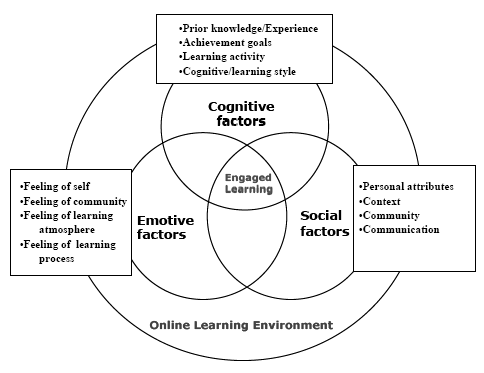Cybergogy
The application of educational technology has created a new teaching and learning concept – cybergogy. One of the central elements of cybergogy is the intent to combine fundamentals of both pedagogy and andragogy to arrive at a new approach to learning (Carrier & Moulds, 2003). Cybergogy focuses on helping adults and young people to learn by facilitating and technologically enabling learner-centered autonomous and collaborative learning in a virtual environment (Carrier & Moulds). At the core of cybergogy is awareness that strategies used for face-to-face learning may not be the same used in the virtual environment. Facilitators need to be mindful of this. Minjuan Wang has presented a synthesis of current thinking, concepts, and theoretical frameworks on the extent and nature of the domains in learner online engagement. The Cybergogy for Engaged Learning model, Wang presents, has three overlapping/intersecting domains: cognitive, emotive, and social. For the online learning experience to be successful, students must be furnished with prior knowledge, motivated to learn, and positively engaged in the learning process. In addition, Wang suggests, they must also be comfortable with the learning environment and feel a strong sense of community and social commitment. Wang proposes that The Cybergogy for Engaged Learning model could be used to conduct needs assessment and to lay out course design and facilitation techniques. Instructors could use this model to profile each student’s cognitive, emotive and social attributes and then effectively engage learners by addressing individual’s learning needs and attributes (Wang, 2007: 5).
Wang, M., J., Kang, M. (2005). Cybergogy for Engaged Learning: A Framework for Creating Learner Engagement Through Information and Communication Technology. In E. M. S. Khine (Ed.), Engaged Learning with Emerging Technologies (pp. 225-253): New York: Springer Publishing.
The continued and growing need for new learning opportunities, linked with newer information systems and communication technologies, has pushed online learning into the center of the discussion of educational practice. There is a need to establish a framework for generating meaningful and engaging learning experiences for distance students with diverse cultural and linguistic backgrounds. We coin the term “Cybergogy” as a descriptive label for the strategies for creating engaged learning online. Our model of Cybergogy for Engaged Learning (see Figure 1) has three overlapping/intersecting domains: cognitive, emotive, and social. This model is a synthesis of current thinking, concepts, and theoretical frameworks on the extent and nature of the three domains in learner engagement online. The instructors can use this model to profile each learner and then design tactics to engage individuals accordingly, a process we call “customized engagement.” As a consequence, learners will not only have the opportunity to accomplish their learning goals, but also will be actively involved in the learning process.
Cognitive Presence Social Presence Emotional Presence
